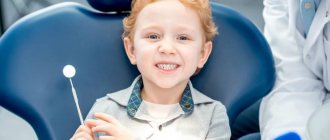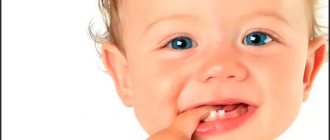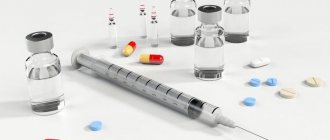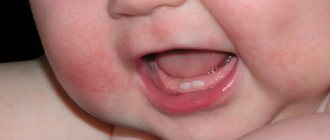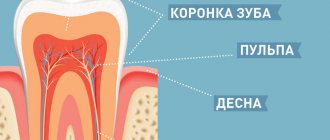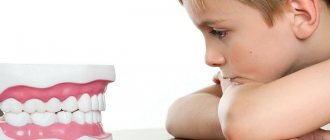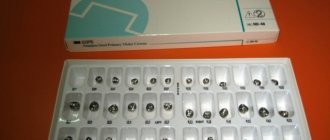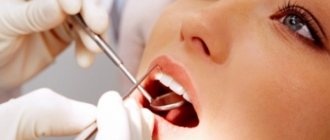Author Peter Deryabin
Updated: 05/07/2020 14:19 Published: 03/30/2004 08:28
Health » Dentistry » Prevention
The questions of our readers about the first teeth of babies are answered today by Candidate of Medical Sciences, Associate Professor of the Department of Pediatric Therapeutic Dentistry of the Moscow Medical Dental Institute. N. A. Semashko Tamara Arkadyevna SMIRNOVA .
How to keep your child's teeth healthy
Irregular growth of teeth in a child: causes and consequences
There are various reasons. Also, the habit of sucking a pacifier is not good for the baby. Later, children start using their fingers and pencils. As a result, we have to deal with myodynamic disorders of the facial muscles.
Consequences of uneven teeth
Scientists have established a relationship between uneven teeth and early caries. Speech defects may also occur. Even while the child is breastfeeding, the prerequisites for underdevelopment of the jaws appear. Often there is also a narrowing (asymmetry) of the dental arches. Even breathing functions are impaired. Swallowing occurs incorrectly. In certain cases, speech is impaired.
Let us note other consequences of uneven teeth. The habit of breathing through the mouth leads to a narrowing of the existing dentition. As a result, jaw growth is delayed.
And when baby teeth are replaced, crowding occurs, and some molars no longer have enough space. Not surprisingly, they are unevenly spaced.
It's not just a matter of unaesthetic appearance. Along with early caries, the child is at risk of premature tooth loss .
Professionals warn about the importance of early diagnosis of defects in order to begin orthodontic treatment on time.
A signal for parents may be mouth breathing at night. The correct option is silent breathing through the nose.
When should you start brushing your child's teeth?
“Should I take my child to the dentist before he starts teething?” N. Simonova, Tambov
Yes, it will be better if the dentist examines the child's mouth before the first teeth appear. It is necessary to check whether the frenulum of the tongue is attached correctly.
If it is short, it may be difficult to feed the baby. The baby may have a hidden cleft of the soft palate, and subsequently he may have problems with speech.
It is worth consulting with a specialist about the timing of teething. They are closely related to the overall health of the baby. They can be used to judge other disorders in its development.
First, teeth should appear on the lower jaw, and only then on the upper. It is important how they erupt: in pairs and symmetrically, as expected, or singly and discordantly. A gap of 1-2 months between the appearance of paired teeth is considered normal.
Later dates, as a rule, indicate some kind of general trouble. You should definitely consult a doctor if your baby’s first teeth are not white, but dark or irregular in shape, for example, sharp, like fangs.
Dental treatment for children
If your baby is not sleeping properly, you should think about the possibility of myofunctional correction aimed at correcting the bite. As a result, free nasal breathing is restored, which has a beneficial effect on the entire body.
Fatigue disappears and the child’s mental activity is stimulated.
It is important to choose the right method to combat the deficiency. One of the newest techniques is myofunctional correction . Both silicone vestibular plates and trainers are used from the age of two. It is at this age that preventive measures are most effective.
Caring for baby teeth
You should start brushing your baby teeth from the moment they appear. To do this, use a special children's toothbrush, placed on your finger, or a gauze cloth, which is moistened with boiled water and wiped the teeth that have erupted. Children's toothpaste and toothbrush begin to be used at approximately 12-14 months. The toothbrush should contain synthetic bristles and match the size of the child’s mouth. The packaging of a children's brush usually indicates what age it is intended for. The brush should be changed every three months, kept clean at all times and must be kept separate from adult toothbrushes. Children's toothpastes are generally designed to be swallowed by most children and therefore have a sweet, fruity taste and do not contain fluoride, which is a health hazard at this age. Up to two years of age, you can brush your baby teeth once a day – in the evening, squeezing a small amount (no more than a pea) of toothpaste onto your toothbrush. Then the child can gradually switch to brushing his teeth independently twice a day - in the morning and in the evening, remembering that brushing in the evening remains the most important.
Thus, by following the above simple rules, you can keep your child’s baby teeth healthy until they are completely replaced by permanent teeth. Remember that you need to take care of your teeth from a young age.
Video: “ Legend of dental Kingdom ”
Podcast: Baby teeth: how to keep them healthy?
© source palmyra.net.ua
Is it worth treating children's teeth under anesthesia?
Each of us remembers what a problem visiting the dentist was in childhood. To avoid unpleasant sensations, specialists are increasingly offering dental treatment under anesthesia. There are many opinions about the correctness of such a decision. Therefore, let's listen to the opinions of professionals.
On the one hand, anesthesia really relieves the child of suffering. But not everything is so simple and unambiguous.
The correct position is that general anesthesia is appropriate when there is a real need for its use.
You need to use the method thoughtfully and not resort to it unless absolutely necessary.
Let's not forget that anesthesia has an effect on the central nervous system, as a result, sleep is disrupted and headaches occur.
The injected drugs destroy a certain number of brain cells.
You should not be surprised by memory and speech disorders. Thinking may be harmed.
Doctors do not say that it is necessary to unequivocally abandon anesthesia in pediatrics. A rational approach consists of a careful and deliberate approach to the use of a radical method of pain relief.
Experts allow the use of anesthesia for children with increased sensitivity to various irritants.
There are also babies with a particularly acute reaction to pain and an increased gag reflex. Let us also take into account the fact that local anesthesia in some cases causes allergies. The use of anesthesia for children with serious mental (neurological) disorders is justified.
Interesting! Hallux valgus in a child: causes
Causes of caries in children
The most common belief is that caries occur only when teeth are not brushed thoroughly enough. This is partly true: indeed, microbes actively multiply in the plaque layer, producing a special substance that corrodes the enamel.
But sometimes it happens that the teeth that have just erupted in the baby are affected. This phenomenon is called early caries, and the factors that cause it can arise in the prenatal period.
The formation of baby teeth in the fetus, as is known, occurs in the first trimester of pregnancy.
Consequently, any disturbances in the functioning of the mother’s body, for example, hypertension, endocrine and respiratory diseases, can cause the embryonic development of caries.
The mother’s balanced diet contributes to the correct formation of the baby’s teeth. Alcohol and smoking during pregnancy are among the most significant and dangerous causes of the development of oral diseases in the fetus.
Note to moms
Although baby teeth begin to erupt at 6 months, and by 2.5 years all twenty teeth are already present, their formation begins already during pregnancy. Therefore, the expectant mother needs to eat food rich in calcium and fluoride, which are the main building materials for teeth. The same is necessary for the child, since after birth the body begins to build permanent teeth, which, after changing the milk ones, should serve him for the rest of his life.
I must say honestly, ideally constructed tooth enamel is the strongest material in the body, which is not afraid of any microbes, the problem is that in most people the enamel is not built perfectly with microdefects, where microbes rush.
How does this happen? After eating, plaque forms on the surface of the teeth, oral microbes interacting with this plaque form an acid, which dissolves the tooth enamel, the first line of defense, forming a carious cavity, after which, rushing inside the tooth, it can reach the living part of the tooth (pulp) and even cause her death.
The later the cavity is detected, the more difficult the treatment will be and the more unpleasant experiences the child will have associated with it. Therefore, prevention is very important.
What problems can parents solve on their own?
From a very early age, minimize the child’s consumption of caramel candies, toffees, sweet suckers, and cakes. You especially have to keep an eye on what grandparents bring. If you want to please your child with something sweet, it would be better if it were fruit, honey, ice cream (dairy products contain calcium, which is good for teeth), or at least real natural chocolate. Under no circumstances should you give sweet drinks at night; at night, ideal conditions for bacteria that cause caries are formed in the child’s mouth; in addition, the child subsequently gets used to sweets faster.
And naturally, it is necessary to brush your child’s teeth twice a day, morning and evening, to prevent plaque formation. You should start brushing your teeth after the first teeth erupt. This can be done simply with a clean napkin or gauze; after two years, you can start using a toothbrush. At first, parents have to brush their teeth together with their child, but the sooner you start accustoming your child to this procedure, the faster he will learn to do it on his own.
And you definitely need to show your child to the dentist at least once every six months. A child's visit to the doctor is always stressful, so it is better if the acquaintance with the dentist begins simply with preventive examinations when the child turns one year old. Subsequently, by the age of three to four years, he will perceive the environment of the dental office more adequately and be more relaxed about treatment if it is needed.
Parents should know that baby teeth, just like permanent teeth, need to be treated and it is obvious that it is better to do this in the early stages of caries development. This avoids oral infection, pain, tooth decay and early removal. Early removal of primary teeth disrupts the normal development of the bite and subsequently leads to orthodontic problems, the correction of which will require large time and financial costs.
Before visiting the dentist, you don’t need to tell your child: “It won’t hurt,” “You’ll have to be patient for a little while,” “They’ll give you an injection,” “They’ll drill your teeth.” This only instills fear in the child. Dentists generally “don’t drill,” “don’t pull,” “don’t prick.”
Today, dental technologies have come a long way and make it possible to provide safe and reliable pain relief; there are new aesthetic and non-toxic materials for treatment and filling.
How to properly treat caries in a child
A negative image of the dental clinic is firmly entrenched in our minds. Everyone is afraid of dentists: both adults and, especially, children. But today's technologies make it possible to do without drilling and other unpleasant methods.
Caries detected in its infancy can be removed with a laser . The device finds the carious lesion, quickly and painlessly neutralizing it.
This disease can also be treated with ozone . The essence of this method is to treat the affected tooth with a thin stream of air with disinfectants.
Do not forget that all these methods can only be applied if you consult a dentist in a timely manner. Teeth with progressive caries can only be filled or even removed.
Prevention of oral diseases in children
Maintain oral hygiene:
1 You need to clean your baby’s mouth regularly, and you need to start doing this long before the child’s first tooth appears.
2 In the first six months of life, the baby’s gums, tongue and folds behind the cheeks should be carefully wiped with gauze, bandage or napkin. Also try to rinse your child's mouth with plain, clean water as often as possible.
3 After the appearance of baby teeth, you need to brush your mouth at least 2 times a day. Children under 3 years of age should do this only in the presence of their parents.
4 You can also use special mouth rinses. Remember that the effect of liquid oral cleansers is much weaker than the effect of toothpaste. Therefore, the use of rinses cannot replace the usual procedure of brushing your teeth.
Professional methods of prevention.
Fluoridation of enamel, application of special preparations to the surface of the teeth, resulting in the formation of a film from which fluoride ions penetrate the enamel and restore its structure.
Sealing of fissures - sealing with a filling material the chewing surface of the tooth, which is most susceptible to caries; the fissures are filled with a special sealant that protects the tooth surface from microbes and acid.
Professional oral hygiene is carried out using a mechanical brush and a special paste, which allows you to remove bacterial plaque that cannot be removed at home.
We must always remember that only through the joint efforts of the patient, his parents and doctors, can the child be kept healthy and the doctor’s visit enjoyable.
How to choose a children's toothbrush
For babies who have not yet started teething, a silicone finger massager can be an excellent alternative to a regular brush. Protruding rubber particles carefully clean the baby's gums and tongue. Silicone brushes also help well with difficult teething.
For older children, brushes are produced with a small plane on which soft synthetic bristles are located.
It is better not to use toothbrushes with natural bristles, as their bristles tend to absorb bacteria, which is not at all hygienic.
Interesting! Atopic dermatitis in children and adults
As the child grows older, larger toothbrush models are selected. Also pay attention to the length and shape of the handle: it should be comfortable for your baby to use the brush. And, of course, do not forget to change these hygiene items in a timely manner. The service life of each cannot exceed 2-3 months.
FAQ about teeth
- When should I take my child to the dentist for the first time? When the first tooth erupts, contact a specialist to evaluate the development of the jaw and give recommendations for care.
- When should you start taking care of your oral cavity? From birth, periodically remove plaque from the tongue using a clean gauze pad.
- Is it worth taking care of your first baby teeth? Yes, take care of them using fluoride-free toothpaste and a special baby brush.
- At what age should fluoride toothpaste be used? As soon as the child stops swallowing the paste and learns to rinse his mouth.
- What is caries? Damage to teeth by bacteria due to excessive consumption of carbohydrates, which destroy the tooth.
- Is it worth treating baby teeth? Yes, otherwise diseases of temporary teeth are transmitted to permanent teeth.
- When will baby teeth fall out? In the period from 5 years to school, the change from dairy to indigenous ones begins.
- Does an overbite need to be corrected? Yes, because there is a risk of developing problems with the digestive tract in the future. Moreover, this is a common reason for complexes in teenagers.
- Should I fill my teeth? Depends on the hole in the tooth. If it is deep, you need to put a filling to protect the tooth from the growth of bacteria.
- How to calm a child in the dentist's office? You need to prepare in advance for the meeting with the doctor and distract with the help of little tricks.
- At what age can professional oral hygiene be performed? After 3 years, when the child learned to rinse his mouth and not swallow the toothpaste.
- What to do if a tooth is lost prematurely? Place a denture.
- At what age can you use an electric toothbrush? From 6-7 years, when the enamel becomes less sensitive.
Read more about:
- Bite correction
- Preventive dentistry
- Promotions in our Center
Make an appointment by calling: city 2-36-00, mobile 8-910-910-10-06, toll-free 8-800-100-31-99 or online on the website.
Make an appointment
How to choose toothpaste for a child
Dentists say that it is unacceptable to use the same toothpaste for all family members. The fact is that the oral cavity of each person has its own individual characteristics.
Therefore, if you come across a toothpaste on the counter labeled “for the whole family” on the packaging, know that such a product is unlikely to be of high quality.
A child should brush their teeth only with a special toothpaste intended for children. It is best to choose a toothpaste that is appropriate for your baby’s age, so be sure to pay attention to the labeling (“from 0 to 4”, “from 4 to 8”, “from 8 to 14”).
Pastes for the youngest should provide the most delicate but thorough cleaning of baby teeth.
Very often, children swallow a certain amount of paste during hygiene procedures, so the composition of the product should be as safe as possible.
As a rule, fluoride in toothpastes from this category is either completely absent or present in very small quantities.
Parents who want to buy only the best toothpastes for their children will have to learn to understand their composition.
The most important substance in any paste is the abrasive (small particles, thanks to which plaque is removed from the enamel). The most suitable abrasives for primary teeth are silicon dioxide or titanium dioxide. These substances do not injure soft tooth enamel and clean it quickly and efficiently.
But it is better not to buy toothpastes that contain sodium biocarbonate or calcium carbonate (which are quite aggressive chemicals), either for your child or for yourself.
What is the optimal amount of fluoride for a child to prevent caries and not lead to fluorosis?
The best way to prevent tooth decay is to add fluoride to your drinking water. An amount of fluoride of about 0.7 parts per million (ppm) in drinking water is sufficient to prevent breakdown without causing fluorosis. Natural water sources may also contain fluoride. If the level of fluoride in the water you drink is 0.3 parts per million or less, it is worth talking to your dentist about what supplements your child should take. If the amount of fluoride in the water is greater than 0.7 ppm, the risk of fluorosis is higher. Children under three years of age should not drink water with fluoride levels significantly higher than 0.7 ppm. How to use toothpaste containing fluoride? Start brushing your child's teeth with a pea-sized amount of fluoride toothpaste when your child reaches 3 years of age. If appropriate, your dentist may recommend fluoride supplements for your child.
